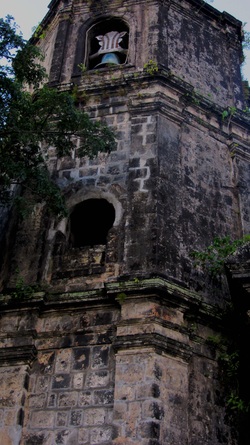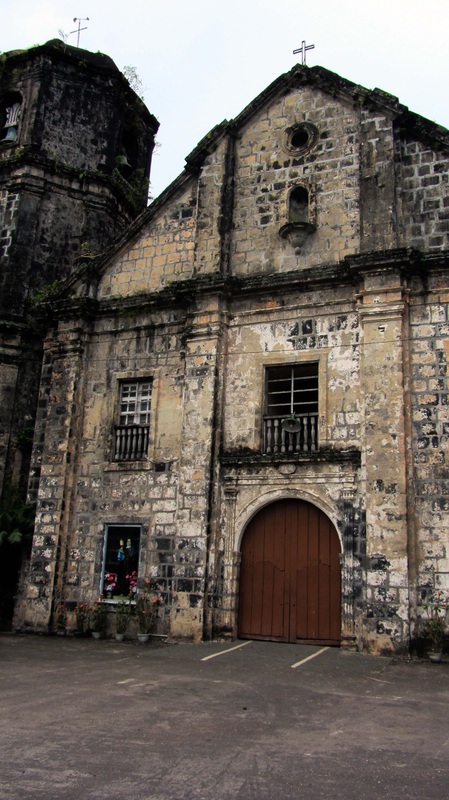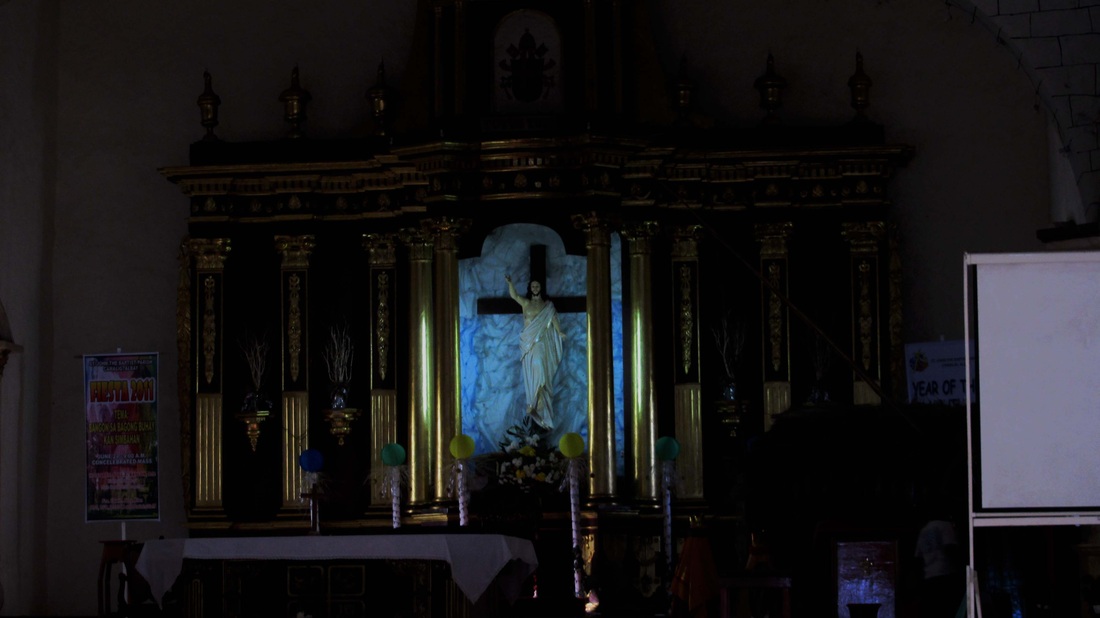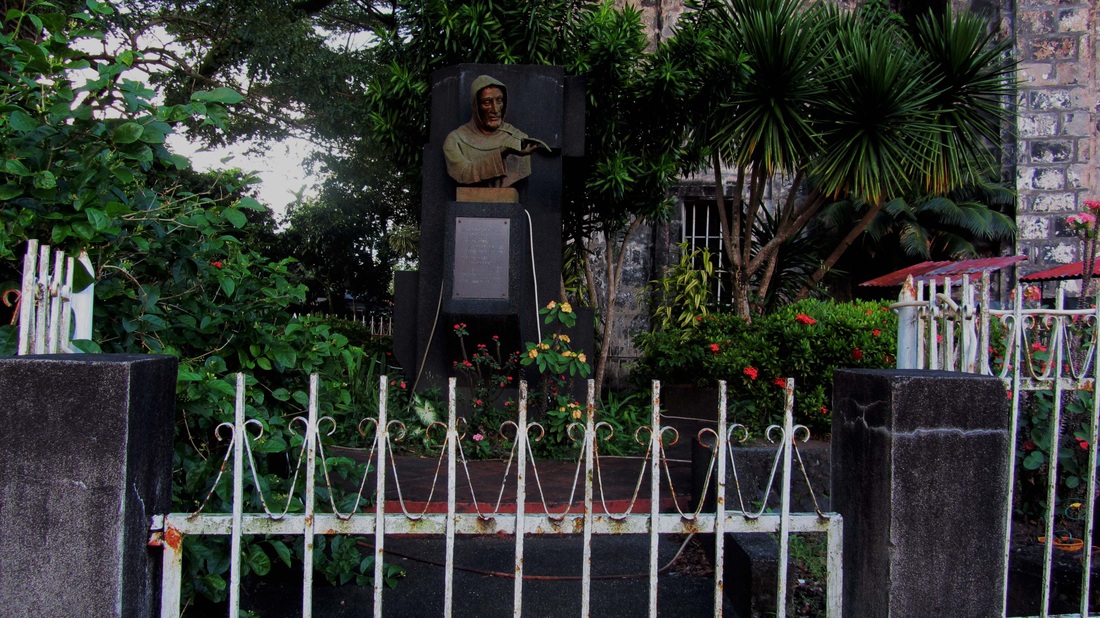
Christianity was brought to Camalig by Capt. Luis de Guzman together with Father Alonzo Jimenez, an Augustinian priest who came with the Legaspi expedition. Evangelization was started in 1578 by the Augustinian missionaries. When the Augustinians left, the Franciscan Fathers Pablo de Jesus and Bartolome Ruiz continued their work. In 1579, Camalig was formally inaugurated as a town and as a parish. The original poblacion was placed in Binanua-an. The original church and “escuela Catolica” was established in this place. In February 1814 Mayon Volcano erupted and totally destroyed Cagsawa and parts of Camalig. This prompted the town officials to transfer the church and the town government to the mountains. First, to Palanog, then to Kitapunte and then to Baligang. However, a big fire raced to the ground the church and the nearby houses. The town government was brought back to the original site in the poblacion and the church that was unscathed by the eruption of 1814 was re-occupied.
A great surge of economic progress brought prosperity to Camalig. In 1842 a huge edifice built as the new church consumed all the volcanic stones of the town. Yet, only the main body of the church and the belfry were finished that year. The pyramid portion of the tower was added years later. Hundreds of stone-cutters worked daily under the supervision of Spanish engineers and the parish priest. It took another six years before the whole structure was completed in 1848. Camalig then, could boast of having one of the strongest, most massive if not the most beautiful among the churches in the Bicol Region. According to Fr. Jose Maria Barrulo, a Spanish Franciscan assigned in Camalig after the liberation of the Philippines from the Japanese said that the church could compare to any of the cathedrals in Europe.
With such a structure to be proud of, the more affluent residents and families of the town vied with one another in providing the interior of the church with expensive furnishings, be they wood, in glass, in silver, gold, brass or copper, including the altar linens and ceremonial vestments. The people generously contributed for the bells, except for the biggest one, which was donated by the Franciscan order, together with the Baptismal Font. Two other marble holy water fonts installed at the entrance and two smaller ones on the west side door were donated by prominent families. Five capitanes each donated a crystal chandelier.
A great surge of economic progress brought prosperity to Camalig. In 1842 a huge edifice built as the new church consumed all the volcanic stones of the town. Yet, only the main body of the church and the belfry were finished that year. The pyramid portion of the tower was added years later. Hundreds of stone-cutters worked daily under the supervision of Spanish engineers and the parish priest. It took another six years before the whole structure was completed in 1848. Camalig then, could boast of having one of the strongest, most massive if not the most beautiful among the churches in the Bicol Region. According to Fr. Jose Maria Barrulo, a Spanish Franciscan assigned in Camalig after the liberation of the Philippines from the Japanese said that the church could compare to any of the cathedrals in Europe.
With such a structure to be proud of, the more affluent residents and families of the town vied with one another in providing the interior of the church with expensive furnishings, be they wood, in glass, in silver, gold, brass or copper, including the altar linens and ceremonial vestments. The people generously contributed for the bells, except for the biggest one, which was donated by the Franciscan order, together with the Baptismal Font. Two other marble holy water fonts installed at the entrance and two smaller ones on the west side door were donated by prominent families. Five capitanes each donated a crystal chandelier.
Such was the glory of the Camalig Church, which could easily compare with the European cathedrals at the time. This glory has outlasted three big wars: the Spanish-American War, World War I and World War II. It has weathered and braved several eruptions of Mayon volcano, strong earthquakes and typhoons. It has seen good days and bad days. It has lived over the different historical period of the country – the Spanish, American and Japanese eras – up to the present.
Because of old age, however, this dear church has succumbed to the fury of the super-typhoon “Sisang” in 1987. The whole structure has been unroofed, the beams and ceiling badly crumbled. But the people of Camalig would not stand beaten by such calamity. They moved as one people to repair and restore their church. All efforts were harnessed to get the materials and finances needed for its reconstruction.
The administration, supervision and maintenance of the parish and the church were taken care of by the Franciscan friars from 1578 to 1983, a total of 405 years. After Vatican II there was a movement for the Filipinzation of the parishes so in 1968 Fr. Antonio Luto, OFM was installed as the first Filipino parish priest. In 1983, the diocese of Legaspi took over the parish from the Franciscan. Fr. Ernesto Alberto (now Msgr. Ernesto Alberto) was installed as the first diocesan pastor of the parish of St. John the Baptist. After his term, he was succeeded by the following parish priests Msgr. Mariano S. Madrid, Fr. Lorenzo de Leon, Fr. Diogenes Barja and now Fr. Leandro de la Cruz.
Because of old age, however, this dear church has succumbed to the fury of the super-typhoon “Sisang” in 1987. The whole structure has been unroofed, the beams and ceiling badly crumbled. But the people of Camalig would not stand beaten by such calamity. They moved as one people to repair and restore their church. All efforts were harnessed to get the materials and finances needed for its reconstruction.
The administration, supervision and maintenance of the parish and the church were taken care of by the Franciscan friars from 1578 to 1983, a total of 405 years. After Vatican II there was a movement for the Filipinzation of the parishes so in 1968 Fr. Antonio Luto, OFM was installed as the first Filipino parish priest. In 1983, the diocese of Legaspi took over the parish from the Franciscan. Fr. Ernesto Alberto (now Msgr. Ernesto Alberto) was installed as the first diocesan pastor of the parish of St. John the Baptist. After his term, he was succeeded by the following parish priests Msgr. Mariano S. Madrid, Fr. Lorenzo de Leon, Fr. Diogenes Barja and now Fr. Leandro de la Cruz.
The interior of the church has also undergone many changes after Vatican II. The first change was made by Fr. Antonio Luto, OFM. The main altar was made to face the people. The communion rail was removed and the Blessed Sacrament was placed in an altar on the east side of the church facing the west. Fr. Herminigildo Salvosa worked for the electrification of Camalig and the organization of the Camalig Credit Cooperative. He also started Basic Ecclesial Communities in the barrios, which died when he left. In 1978 during the term of Fr. Baltazar Obico the roof of the church over the main altar was destroyed by typhoon Liling. So the altar was removed and a wooden altar was made and placed nearer to the congregation. This altar was changed by Msgr. Madrid with a very spacious altar and a baptismal font at the rear of the church based on the Neo catechumenal rite of the liturgy of the Eucharist and baptism. The altar has remained to the present. The Blessed Sacrament was then carved in a niche on the wall of the eastern side of the church facing the east. He also started the use of marble slabs on the main altar and the crucero. Fr. De Leon replaced the baked red tile flooring with marbles slabs. He demolished the baptismal font and transferred the Blessed Sacrament from the niche to the tabernacle where it is now. During Fr. Barja’s term, his first project was to put up a good sound system and purchased a brand new electric organ. He renovated the convent, the kitchen, refectory and comfort rooms. He greatly enhanced the cleanliness of the church and the convent. The area in front and at the back of the church was converted into a garden. Fr. Barja was not only concerned with the physical appearance of the church. He organized Basic Ecclesial Communities (BEC) in the barrios; Parish Renewal Experience (PREX); strengthened the Parish Social Action Commission (PSAC) and the Parish Youth Commission, BUGKOS – Camalig. Fr. De la Cruz is just starting his term so his plans and projects still remain to be seen.
Source: http://tourism.albay.gov.ph/camaligchurch.htm
Source: http://tourism.albay.gov.ph/camaligchurch.htm













